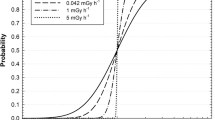Abstract
The biomedical radiation research community has important goals. Research, risk assessment, preventative health and safety are some of its responsibilities. It is surprising that radiation research is growing only at 70% of the yearly Medline database. Funding is predictably underfunded (89% of expected) given its high percentage of research with animals and cells (127% (Medline = 100%)) vs. radiation's lower percentage of human studies (60%). Manpower studies demonstrate 4500 Ph. D.'s since 1960. 50% are in physics, 17% chemistry, and 11% biology. Biochemistry, pharmacology, microbiology, genetics, pathology and psychology contribute less than 3%. These indicators show activity in radiation research, yet deficits.
Similar content being viewed by others
References
L. W. Davis, J. Cox, J. Diamond, D. Flynn, F. Halberg, W. Moss, The manpower crisis facing radiation oncology,International Journal Radiation Oncology Biology Physics, 12 (1986) 1873–1878.
E. Garfield, Citation analysis as a tool in journal evaluation,Science, 178 (1972) 471–9.
E. Garfield, The journals pathologist's write and the journals pathologists cite,Pathology Annual, 11 (1976) 335–51.
E. Garfield, Which medical journals have the greatest impact.,Annals of Internal Medicine, 105 (1976) 313–20.
E. Garfield,Science Citation Index, 1975–1986. ISI Press, Philadelphia, PA.
Grants of the Public Health Service, Govt. Print, Wash., D. C., 1975–1980.
R. B. Haynes, K. A. McKibbon, D. Fitzgerald, et al., How to keep up with the medical literature: II. Deciding which journals to read regularly,Annals of Internal Medicine, 105 (1986) 309–12.
Library Operations,Medical Subject Heading, National Library of Medicine, Bethesda, MD; 1986.
National Science Board,Science Indicators, 1976, National Science Foundation, Washington, D. C., 1977.
National Academy of Sciences,Federal Research on the Biological and Health Effects of Ionizing Radiation, National Academy Press, Washington, D. C., 1981.
P. Rubin, The emergence of radiation oncology as a distinct medical specialty,International Journal of Radiation Oncology Biology Physics, 11 (1985) 1247–1270.
W. H. Shapley, D. I. Phillips,Research & Development A. A. A. S. Report IV, American Association for the Advancement of Science, Wash., D. C., 1980.
H. Zuckerman,Scientific Elite: Nobel Laureates in the United States, Free Press, Macmillan Publishing, New York, 1977.
G. K. Macleod, W. R. Hendee, M. R. Schwarcz (Eds)JAMA, 1986, 632–634.
A. Upton, Low level radiation exposure,Scientific American, 246 (1982) 41–49.
R. L. Brent, Radiation Teratology, In:Handbook of Teratology,J. G. Wilson,F. C. Fraser (Eds), Plenum Press NY, 1977, pp. 153–224.
Author information
Authors and Affiliations
Rights and permissions
About this article
Cite this article
Steinberg, J.J. The state of biomedical radiation research as demonstrated by publications, funding and manpower activity: An analytical example of utilizing on-line medical informatics. Scientometrics 27, 283–294 (1993). https://doi.org/10.1007/BF02016943
Received:
Issue Date:
DOI: https://doi.org/10.1007/BF02016943



